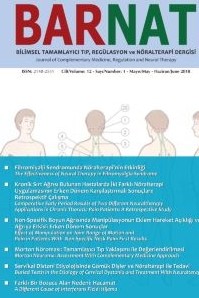MANÜEL TIP VE ORTOPEDİ
Manüel Tıp (MT) elle uygulanan tıbbi bir teknik olup özellikle hareket organlarında (Lokomotor Sistem) reversible işlev bozuklularının (disfonksiyonların) belirlenmesini ve giderilmesini sağlar. Empirik gözlemlerden oluşmuştur ve bu gün MT anatomiye, biyomekaniğe ve nörofizyolojiye dayanır. Topografik – anatomik bilgilere göre uygulanacak olan palpasyon yanında, tanı Medulla oblongata ve Spinalis’in proprioseptif ve nosiseptif laminalarındaki multiseptif nöronların afferent konvergens bilgi aktarımı üzerinden segmental veya artiküler disfonksiyonlara dayanır, bu suretle motorik ve sempatik sistem aktivasyonu ve ilgili segmental- bölgesel fonksiyon bozuklukları uyarılır (provoke olur).Manüel terapi tek seferde hızlı, segmental uygulanan manipülasyon impulsları veya yavaş-yumuşak-ritmik tekrarlanan mobilizasyonlar esnasında, inhibitorik reseptif alanların aktivasyonu vasıtasıyla noziaferentlerin giderilmesini hedef alır. MT’nin geliştirilmesi Bologna konseptine göre diploma ile gerçekleştirilir. MT öncelikli olarak hareket organlarında gerçekleştiğinden ortopedi ve travmatoloji cerrahlarının ileri eğitimlerinde yer bulmalıdır. Ayaktan tedavide (günlük rutin poliklinikte) MT eğitimi olmayan bir ortopedi travmatoloji cerrahı eğitim almış bir aile hekiminin deneyimine mağlup olacaktır
Anahtar Kelimeler:
Reversible disfonsiyonlar, Nozizeptive Konverjans, Motorik-sempatik Koruma reaksiyonu, Manüel tedavi, Manüel Terapi eğitimi.
MANUEL MEDICINE AND ORTHOPEDICS
Manual medicine (MM) is a manual medical technique to identify and treat reversible dysfunction especially of the musculoskeletal system. The origins of MM were derived from empirical observations but MM is nowadays based on anatomy, biomechanics and neurophysiology. Besides special training in palpation according to precise topographic anatomic knowledge, the diagnostics of segmental or articular dysfunction are also based on knowledge about afferent convergence of multiceptive neurons located in proprioceptive and nociceptive layers of the brain stem and spinal cord. This leads to activation of motor and sympathetic reactions with the consequence of segmental or regional dysfunction. Manual therapy aims to eliminate noci-afferents as well as to activate inhibitory receptive fields. This can be achieved either. by a single high velocity manipulative impulse or by slow-soft rhythmic repetitive mobilization. The special medical education and training in MM is outlined in relation to the Bologna postgraduate concept. As MM is basically used in relation to the musculoskeletal system it should definitely be incorporated into the specialization for orthopedics and traumatology and become part of the examination. In outpatient medicine an orthopedic and trauma surgeon without MM expertise will be inferior to a general practitioner with this expertise
Keywords:
Reversible dysfunction, Nociceptive convergence, Motor sympathetic defence reaction, Manual therapy, Manual education and training,
___
- Airaksinen O, Brox JI, Cedraschi C et al (2006) Euro- pean guidelines for the management of chronic non-specifi c low back pain. Eur Spine J 15(Suppl 2):192–298
- Assendel WJJ, Morton SC, Yu EI et al (2008) Spinal manipula ve therapy for low-back pain. Cochrane Database Syst Rev 1:CD000447. Edited (no change to conclusions), published in Issue 4
- Bischoff HP, Moll H (2011) Manüel Tıp eği m kitabı, 6. Baskı. Spi a, Ba- lingen
- Böhni UW, Lauper M, Locher H (2012) Manüel Tıp 2. Tanı ve terapide pra k uygulama teknikleri. Thieme, Stu gart
- Federal hekimler odası (BÄK), Kassenärztliche Bundesvereinigung (KBV), Bilimsel çalışma birliğinin bbi uzmanlık ortaklıkları (AWMF) (2010) Na - onale Versorgungs- Leitlinie Kreuzschmerz. h p://www.versorgungs- le- itlinien.de/themen/kreuzschmerz
- Frölich E (2009) Manüel Tıp – Tanı ve tedavi için bbi dokunma sa- na In: Heymann W v (Hrsg) Manüel Tıp. MWE- Selbstverlag, Isny- Neutrauchburg. h p://www. manuelle-mwe.de
- George SZ, Bishop M et al (2006) Immediate eff ects of spinal manipula- on on thermal pain sensi vity: an experimental study. BMC Musculo- skelet Disord 7:68–78
- Heymann W, Böhni U, Locher H (2005) Manüel p hakkında temel araş- rmalar. Almanca konuşan manüel p uzmanlarının Bodensee konferan- sı sonuçları, Bad Horn Temmuz 2005. Man Med 43:385– 394
- Jänig W (2011) Ağrının patalojisi; Motorik geri dönüşler ve ağrı. In: Fisc- her L, Peuker E (Hrsg) Integra f eği m kitabı Schmerztherapie. Haug, Stu gart, S 35–70, 81–89
- Bischoff P, Beyer L, Güntert A et al (2004) Kursbuch Manüel Tıp/Chirothe- rapie. Federal Hekimler Odası, Köln
- Lederman E (2007) Manüel terapinin uygulanması. Fizyoloj, nöroloji ve psikoloji. Elsevier, München
- Locher H (2010) Hareket organlarında ağrıda ağrı analizi ve rasyonel fark- lılık yaratan terapinin oluşturulması. Uygulama açısından önemli temel bilim bilgilerine göre tespitler. Orthop Prax 46:57–74
- Mense S (2003) Kas ağrısında özel olan nedir? Ağrı17:459–464
- Muller R, Giles LG (2005) Long term follow up of a randomized clinical trial, assessing the effi cacy of medica on, acupuncture and spinal mani- pula on for chronic mechanical spinal pain syndromes. J Manipula ve Physiol Ther 28:3–11
- Neuhuber WL (2005) M. longissimus als Vermi ler zwischen kraniozervi- kalem Übergang und Becken. Man Med 43:395–399
- Pickar JG (2002) Neurophysiological eff ects of spi- nal manipula on. Spi- ne J 2:357–371
- Rubinstein SM, Middelkoop M van, Assendel WJJ et al (2009) Spinal manipula ve therapy for chronic low-back pain (Protocol). Cochrane Da- tabase Syst Rev 4:CD008112
- Seffi nger MA, Najm WI, Mishra SI et al (2004) Re- liability of spinal pal- pa on for diagnosis of back and neck pain: a systema c review of the literatu- re. Spine 29:413–425
- Triano JJ (2001) Biomechanics of spinal manipula- ve therapy. Spine J 1:121–130
- Jähnig W (2005) Alterna f pta refl eks terapilerinin nörolojik temel esas- ları. In: Bühring M, (Hrsg) Alterna f p işlemleri ve konvensiyonel olmayan tabbi yönler, 2.Baskı., Yayın 1.06. Springer, Berlin Heidelberg New York
- hekimlerce öğrenilecek ve uygulanacak bir disiplin dalı ola
- ISSN: 2148-2551
- Başlangıç: 2006
- Yayıncı: Bilimsel Nöralterapi ve Regülasyon Derneği
